Christmas in Newport, Rhode Island
A holiday visit to Newport, Rhode Island, offers a merry whirlwind of shopping, dining, and strolling against a historic seaport backdrop.
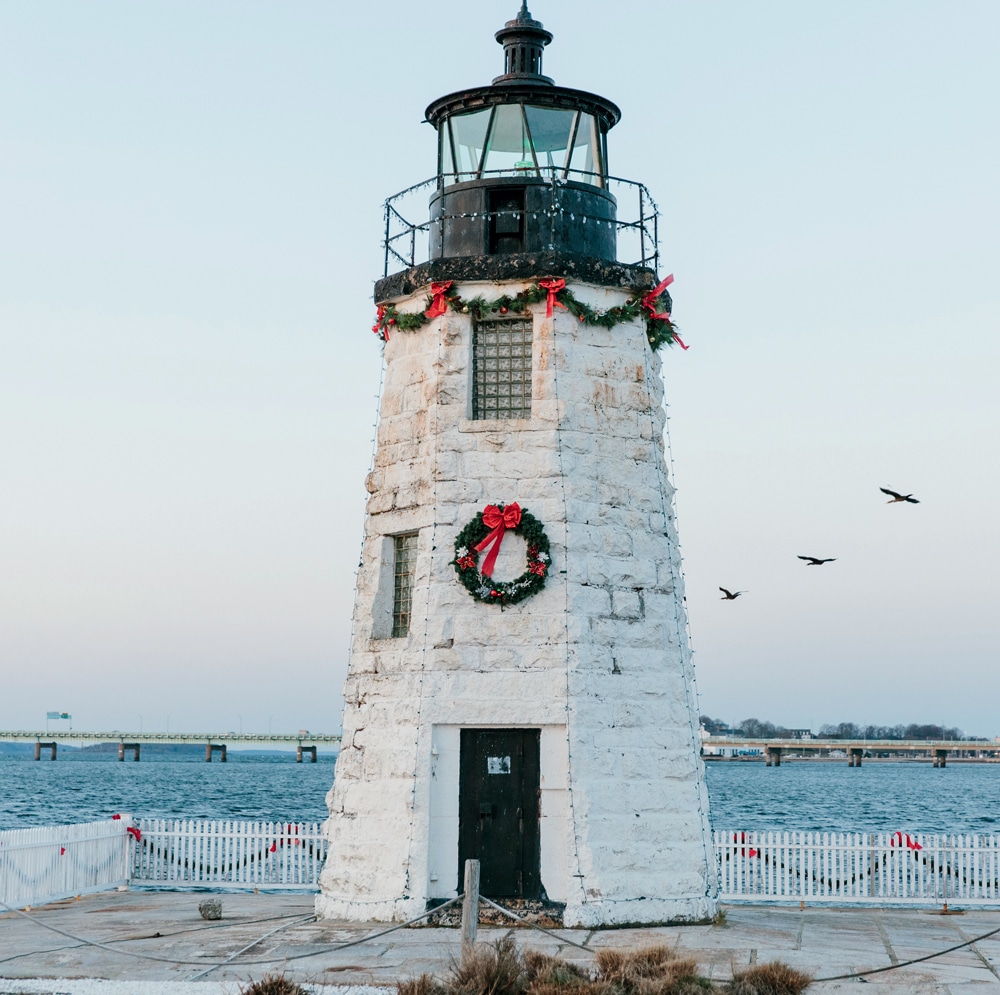
Coffee By Design | Portland, Maine
Photo Credit : Katherine Keenan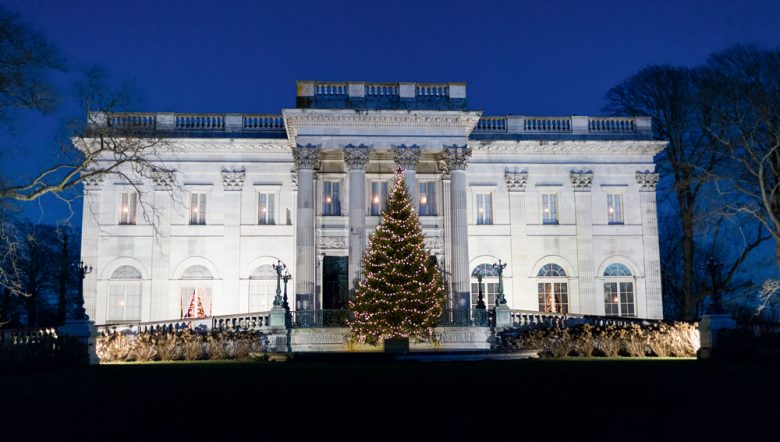
Photo Credit : Erin McGinn
I am working my way through a bowl of clam chowder under the low, age-darkened beams of the White Horse Tavern. I have shopping bags at my feet, my Christmas list on the table. A fire warms the room. Every stool at the bar is taken. I’m tempted to linger in this snug, nearly 350-year-old pub, and to mark my last day here in Newport, Rhode Island, with a Dark ’n’ Stormy as a nod to the town’s rum-running roots. But that would make me late for an afternoon screening of It’s a Wonderful Life. And the fact is I’m already way overdue; I’ve never seen the classic holiday film.
Wind sweeps up from the harbor and rattles the boughs of bare elms as I cross Washington Square, the trapezoidal centerpiece of downtown Newport, to the Jane Pickens Theater. The restored Greek Revival movie house, built as a church in 1834 and converted into a theater in the silent-film era, has a vintage marquee, an old-school glassed-in ticket booth, and—what’s this?—a cocktail bar behind the lobby candy counter. I bring a drink into the packed house, find a seat, and wait for the lights to dim.
—
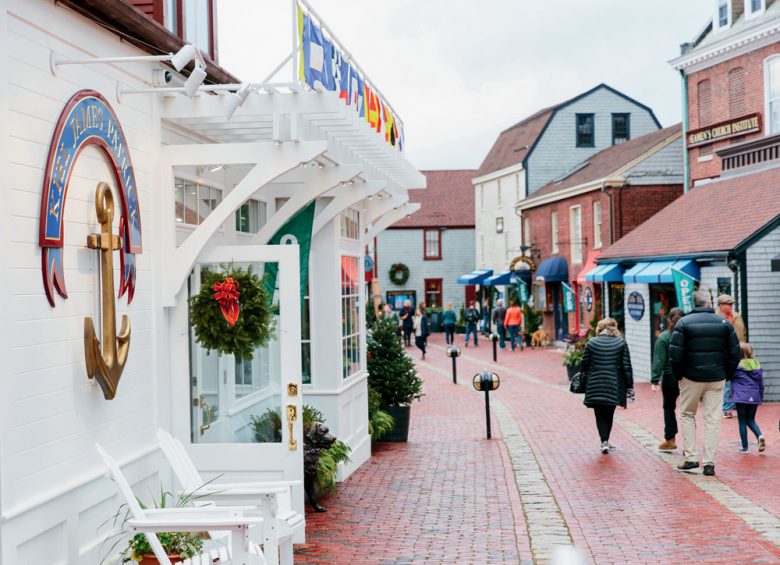
Photo Credit : Erin McGinn
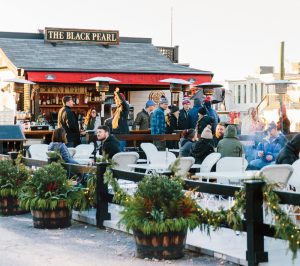
Photo Credit : Erin McGinn
I’d spent a mid-December weekend bouncing around this historic seaport town so deeply associated with summer pleasures—boats, beaches, opulent oceanfront “cottages”—and discovered that it throws itself into the holiday season with equal gusto. The monthlong Christmas in Newport festival, produced by more than 1,500 volunteers, jams the calendar with tours, concerts, craft fairs, and other events that are either free or raise money for local charities. Since its inception in 1971, organizers have also created, to great effect, a kind of dress code for the community by asking that only clear bulbs be used in holiday displays. When those lights come on in the blue-violet twilight, outlining everything from windowpanes to wharf posts, Newport feels twinkly and enchanted—like one of those ceramic tabletop holiday villages come to life.
I felt that magic as I walked on Bannister’s and Bowen’s wharves, where chowder houses, bars, shops, and galleries—all aglow, all busy—occupy what were once colonial-era chandleries and sail lofts. And I felt it when I left that bustle behind and went alone to the end of a long dock where a single lit tree sent its simple good tidings out across the harbor chop.
—

Photo Credit : Erin McGinn
I’d missed the season-opening illuminated boat parade and the roving retail block party that is the Holiday Stroll, but I’d checked in at the Francis Malbone House—a cream-colored brick mansion built in 1760 for a wealthy shipping merchant on harbor-hugging Thames Street—just in time to hear the results of the townwide doorway decoration contest.
“We won,” said Will Dewey, the inn’s soft-spoken owner, as he helped me bring my bags through a front entrance framed with long-needle pine garlands and berry-and-cone-garnished swag. “Just found out. The grand prize.”
The interiors seemed equally award-worthy. In the elegant, wainscoted parlors off the broad central hall, Dewey and his staff had decked the mantels, tables, and sills with umbrella pine boughs, gilded magnolia leaves, poinsettias, wrapped boxes, candles, and fruit-studded miniature trees. Afternoon tea was under way in one of the common rooms. The spread—chicken velouté, grilled pizza, artichoke crab dip, cheddar scones, maple chocolate chip Bundt cake, Linzer cookies, apricot biscotti, and more—covered a large dining table.
“I tell guests to make late dinner reservations,” Dewey said with a laugh when I commented on the abundance of food. “I think some people don’t go out to dinner at all.”
I would have filled a plate and parked myself in a wing chair by one of the blazing fireplaces, but I’d made plans to join a group walking tour that was setting off soon from the Museum of Newport History at the foot of Washington Square.
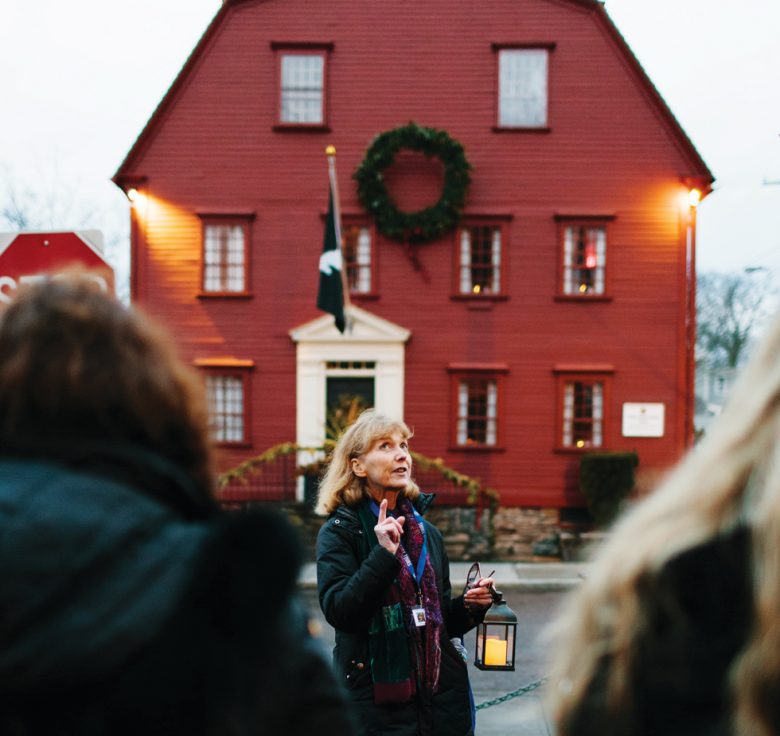
Photo Credit : Erin McGinn
In the chilly dusk, I followed our guide, Pat—petite, gray-haired, toting a lantern—away from the town center and down narrow streets lined with wreath-hung gas lamps and antique clapboard houses. On the corner of Farewell and Marlborough, we paused. On one side was the gambrel-roofed White Horse Tavern, dating back to 1673; on the other, the expansive, austere Great Friends Meeting House, built in 1699. The air smelled of wood smoke. Overhead, black birds swirled in fluid murmurations. A church bell began tolling the hour. For a moment, centuries dropped away.
Christmas came and went with little acknowledgment in those days, Pat said. Throughout New England, early settlers rejected the carousing and high jinks (what influential Puritan ministers of the day decried as “mad mirth”) that had been standard yuletide behavior back in England. For a time, Christmas was even outlawed.
It wasn’t until the 19th century that the holiday gained widespread acceptance and morphed into a season associated less with debauchery and more with domesticity, gift-giving, and goodwill. That attitude shift, it turns out, was thanks in part to a seasonal resident of Newport, Clement Clarke Moore. Moore was a New York City classics professor when he wrote “A Visit from Saint Nicholas,” also known as “The Night Before Christmas,” in 1822 for his children. By 1850, when he began spending summers in a rambling Victorian house on Newport’s Catherine Street, his widely published poem had become the national blueprint for a happy, and Santa-centric, Christmas.
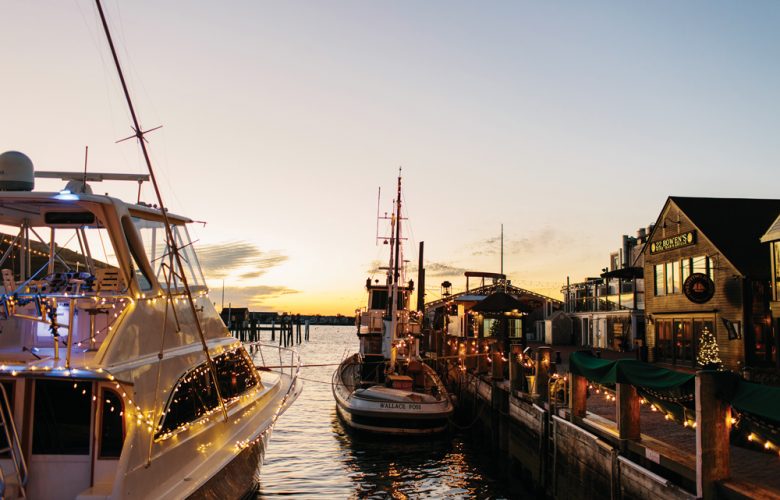
Photo Credit : Erin McGinn
After the tour, I headed back toward the harbor. In the hopping Midtown Oyster Bar, over a platter of local oysters—briny Dutchies, buttery Sakonnets, and creamy Sea Cups—and a pint of Rhode Island–brewed Whalers Rise pale ale, I studied my Christmas in Newport calendar and plotted my next days. There would be visits to the famed Gilded Age mansions, for sure, and perhaps a stroll on the 3½-mile seaside Cliff Walk. And there would most certainly be shopping.
In the morning, I drove down Bellevue Avenue, where turn-of-the-20th-century tycoons with now-familiar names like Vanderbilt, Astor, and Morgan built grand summer palaces and filled them with precious art and furnishings. Three of the most lavish estates are museums that stay open year-round: the Elms, modeled after a mid-18th-century French château; Marble House, inspired by the Petit Trianon at Versailles; and the Breakers, Cornelius Vanderbilt II’s gonzo 70-room Italian Renaissance palazzo. At Christmastime, hundreds of volunteers pitch in to deck them out for the holidays.
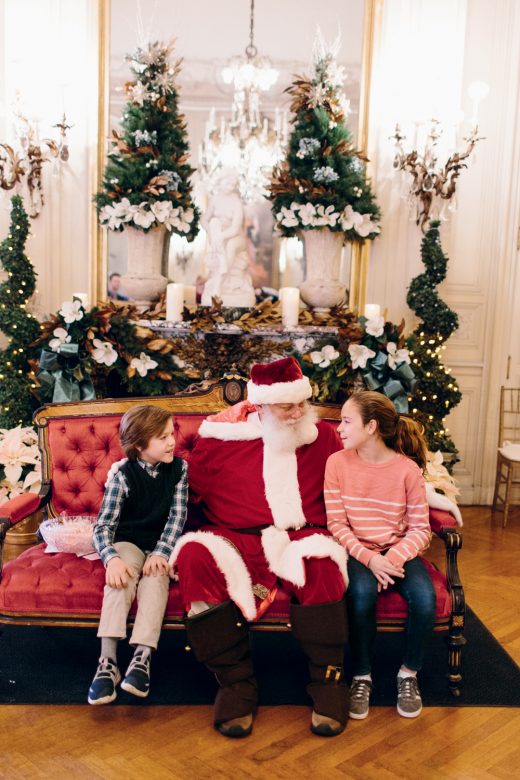
Photo Credit : Erin McGinn
I spent the day drifting up grand marble stairways and in and out of gold boudoirs and crimson parlors, listening to audio tours that spilled tales of extravagance and bad behavior. The trimmed trees, set banquet tables, and draped mantels perfectly matched the mood and style of each room—as if Martha Stewart and Marie Antoinette had co-captained the fantasy league decorating team. And it was pure fantasy; the mansions’ owners never actually spent Christmas there.
I found a more historically accurate view of what Christmas was like for Newport’s elite at Rough Point, the summer home of heiress, art collector, and philanthropist Doris Duke. Though a few of the rooms in the sprawling, waterfront English manor house had been spruced up for the holidays, most were shown as they were when Duke was traveling: shrouded in ghostly white dust covers, awaiting her return. I lingered in the airy, ocean-view solarium, imagining Duke gazing out at the moody surf and her two beloved pet Bactrian camels, Princess and Baby, who roamed the grounds from 1988 to 1992. (It’s said she brought the camels, now immortalized in two life-sized topiaries on the front lawn, into the solarium to ride out a hurricane.) Duke’s eccentricities—she pursued belly dancing, longboard surfing, and gospel singing—were legendary, but she was also a generous and passionate preservationist. In 1968, she started the Newport Restoration Foundation, which in the past five decades has invested in and restored more than 70 early-American houses in town.
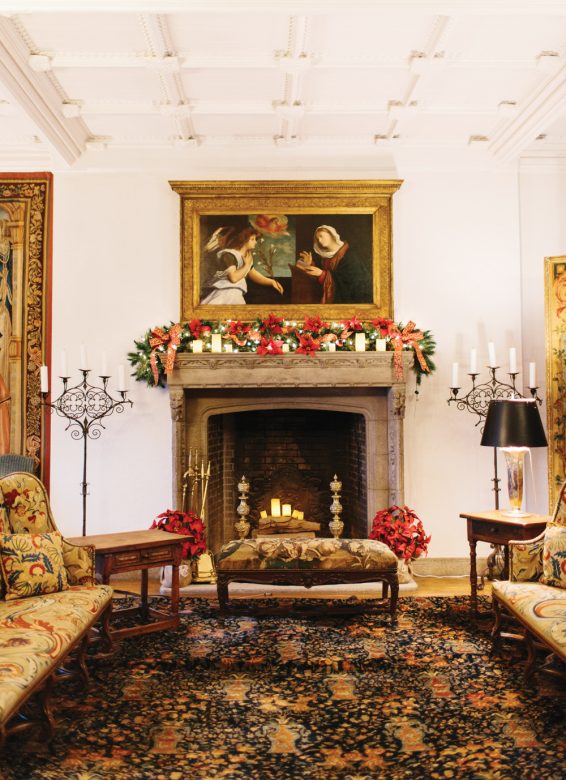
Photo Credit : Erin McGinn
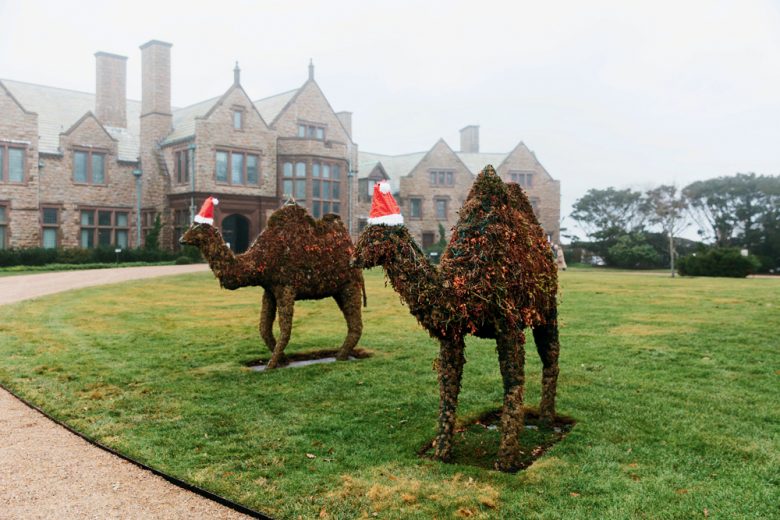
Photo Credit : Erin McGinn
Though it was starting to rain and the wind had picked up, I decided to set off on the Cliff Walk. I was dressed for the weather and figured I’d brave it for a mile, maybe two. And how nice to have the famed coastal footpath and those extraordinary ocean and mansion views to myself. After 10 minutes, the showers had become a deluge; the wind, a bitter, head-turning gale. I turned back. Some things, I had to admit as I dove for the shelter of my car, were best left for pleasant days—and walking by the sea was one of them.
After a day of rococo and drama, I was ready for a glass of wine and the clean lines of TSK (Thames Street Kitchen), a downtown restaurant that reopened in the summer of 2018 after a three-year hiatus. With its concrete tables, modern leather chairs, and hip-hop soundtrack, TSK is the antithesis of Vanderbiltian overkill. That was by design, according to Julia Jenkins-Hoffer, a fifth-generation Newporter who owns the restaurant (and two other casual eateries) with her twin sister, Anna, and their chef husbands, Chad Hoffer and Tyler Burnley, all in their 30s.
“A lot of people think Newport is this stuffy town, with all this wealth. There is some of that, but that’s not who we are, and it’s not who most of the people who live here are,” Jenkins-Hoffer told me. “We wanted to give off a fun, cool vibe—while offering food that is refined.”
It’s a mash-up that works. My dinner was terrific, from the single, doorknob-size raviolo topped with bits of serrano ham and filled with ricotta and a runny egg, to the duck breast with cocoa nibs and pear puree, to the hazelnut tuile cookie topped with a swirl of sweet potato mousse.

Photo Credit : Erin McGinn
In the morning, I put my folded gift list into my pocket and headed to the shops along the wharves and beyond. I considered a sea urchin–shaped platter in the Newport Mansions Store, nautical cord bracelets in Kiel James Patrick, a Breton striped sweater in Monelle. Maybe I would come back for those later. I was humming carols by the time I committed to wooden cocktail muddlers and locally harvested sea salt at the Museum of Newport History gift shop, and dark chocolate lobsters in the Newport Sweet Shoppe. In Farmaesthetics, a serene organic skin-care boutique, I pondered an orange-and-clove-scented scrub called Hot Toddy for the Body, and in Kristen Coates, an eclectic gallery and home decor shop, I waffled between mini versions of Grace Windsor’s striking oyster shell paintings and Ashley Provencher’s vibrant linear seascapes.
Coates herself was behind the counter of her namesake store, which she opened in her hometown after returning from stints in the fashion and art worlds in Los Angeles and New York. In 2016, she cofounded the Holiday Stroll to promote local shopping—and to help get the word out that Newport is a town for all seasons.
“This is absolutely my favorite time of year here,” Coates said. “It’s so festive and has this old-timey feeling. I think people come here and say, ‘This is it. This is the quintessential New England town, and I have to be here at Christmas.’”
I had to agree.
I hoisted my shopping bags. I wanted to see the inside of the old White Horse Tavern and I was ready for lunch. As I passed the Jane Pickens Theater, I noticed It’s a Wonderful Life was showing later that day. I knew how my visit would end.
—
The credits roll. The house lights come up. Clarence has earned his angel wings; human kindness has prevailed. I move with the happy, teary crowd to the theater exit, half expecting to see film-set snowflakes, fat as cotton balls, falling from the sky. Instead, a weighty mist scented with brine and balsam has settled on the town. I take the long way back, poking around in a few more shops, reading posted menus and historical markers, smiling at a group of women who come out of a bar singing jubilantly off-key.
I cut down one quiet cobbled lane, then another. From somewhere on the water’s edge, a foghorn is sounding its low trumpet. It’s dark by the time I get back to the inn, and up and down Thames Street the damp air, like an impressionist’s deft brush, has created coronas around each street lamp, as ethereal and as lovely as halos.
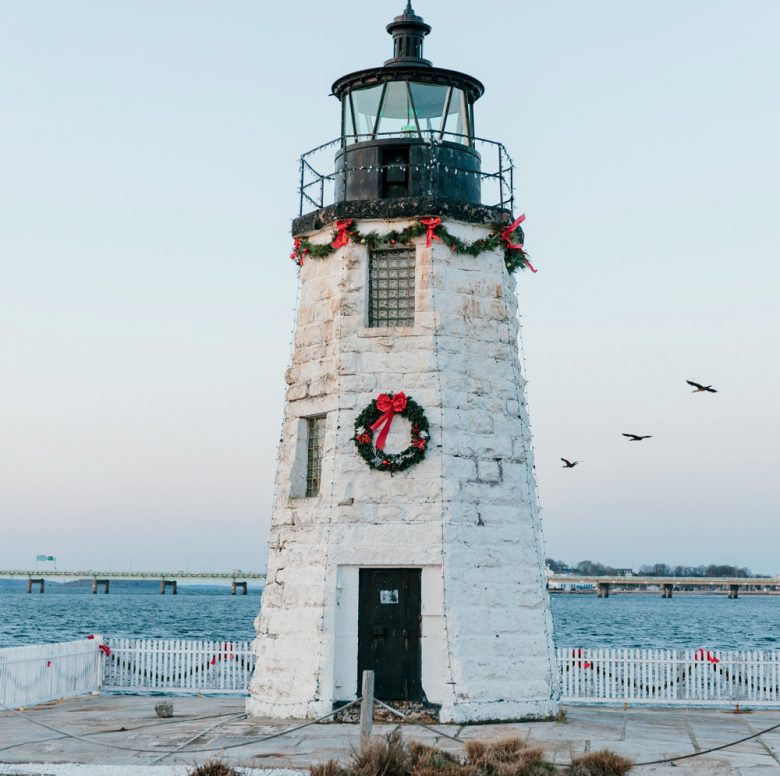
Photo Credit : Erin McGinn
Holiday Events in Newport, Rhode Island
Holiday Lantern Tours Nov. 22–Dec. 28 The savvy guides of the Newport Historical Society light the way during this stroll through Newport’s Christmas past. Offered Friday and Saturday afternoons. 401-841-8770; newporthistorytours.org
Christmas at the Newport Mansions Nov. 23–Jan. 1 Like grand dames dripping with jewels, three famed Newport mansions—the Breakers, the Elms, and Marble House—are dressed to dazzle in 30 Christmas trees and a constellation of ornaments. 401-847-1000; newportmansions.org
The Newport Nutcracker Nov. 27, 29, and 30; Dec. 1 and 3–6 This nearly two-decade local tradition immerses ballet fans in the story of Clara and her Nutcracker Prince as it unfolds throughout the historic Rosecliff mansion. 401-847-4470; islandmovingco.org
Bowen’s Wharf Holiday Block Party and Boat Parade Nov. 29 The waterfront becomes a winter wonderland filled with live music, special deals at local shops, and boats glittering with lights from stem to stern. bowenswharf.com/events
Christmas in Newport Dec. 1–31 From concerts and craft fairs to New England’s largest gingerbread lighthouse, it’s nonstop merrymaking all month long with a slate of 70-plus holiday activities that are free or benefit a charity. christmasinnewport.org
Bowen’s Wharf Tree Lighting Dec. 7 Frosty the Snowman and a Christmas carol sing-along set the stage for Mayor Jamie Bova’s lighting the wharf’s 30-foot tree, immediately followed by the arrival of Santa and Mrs. Claus by boat. bowenswharf.com/events




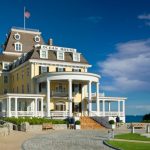

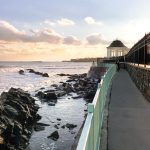

A beautiful time of year captured by Yankee in an inspiring way.
I too spent a magical Christmas weekend in Newport several years ago. I was expecting “closed for the season” storefronts and a sparse amount of visitors. Instead I was transported to Christmas in New England partly as it might have been and some very 21st century. Your article reawaken my memory of that weekend with the scents in the air and the mist on my face. Thank you.
Going a month too early! Bummer
I loved everything you presented in this article. As I scrolled through it I kept anticipating seeing the Rose Island Lighthouse and grounds. I had the good of spending five different weeks there long ago and hoped I could make a visual return visit there via this article. So sad Rose Island was not featured. Scrolling to the lighthouse at Goat Island, I thought surely your article would take me the one more nautical mile across the Narragansett to that enchanting Island. Maybe next time??? Yet, thank you again for all the rest of the sites and memories of Newport, Rhode Island.
Hi there! While we didn’t make it to beautiful Rose Island for this holiday feature (visits to tour the island are only permitted from late May through Labor Day), we shared a web-exclusive visit from September 2015 here. You can also see our tour of Rose Island Light in a season 2 episode of Weekends with Yankee, our public television show in collaboration with WGBH. Thanks!
Wow….beautiful descriptions of beautiful Newport at Christmas….it’s simply beautiful!!
I think winter in Washington Square is so charming, with all the local neighborhood eateries, the small colonial town feel of a time gone by, it just feels cozy and homey especially when it snows!